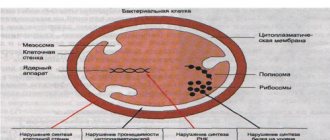- August 14, 2019
- Infectious diseases
- Svetlana Pavlova
Intestinal infections are dangerous diseases that often affect people of all age groups. They are caused by bacteria, viruses and toxins. A pathological process develops in the body, which provokes disruption of the functioning of the gastrointestinal tract (GIT). Infection occurs when food and water containing infected microorganisms are consumed. In this article we will look at what intestinal infections are, how to identify them and why they occur.
Classification of infections depending on the pathogen
Gastrointestinal infection is one of the most common infectious pathologies in the world. There are more than 30 types of this significant group of diseases that affect more than a billion people every year. According to medical statistics, they rank third among all infectious diseases. Depending on the type of pathogen that caused the disease, there are the following types of intestinal infections:
- Bacterial - they are caused by pathogenic bacteria: E. coli, Shigella, Salmonella. They are transmitted through water, food, dirty hands and objects.
- Viral – the culprits of the disease are rotaviruses, adenoviruses, enteroviruses. Infection occurs by airborne droplets, through food, dirty hands and objects.
- Fungal – when immunity decreases, Candida fungi often multiply in the intestines.
- Protozoans – provoke protozoan pathogens. Spread by insects, sometimes sexually transmitted.
Mechanism of transmission of infection
Mechanism of transmission of infection
-
a complex process that consists of three phases, following one after another:
1) removal of the pathogen from the infected organism; 2) presence of the pathogen in the external environment (or in the body of a carrier animal); 3) introduction of the pathogen into a susceptible organism.
The method of removing the pathogen from an infected body depends on its location in the body. When the pathogen is localized in the intestine, it is excreted in feces and sometimes in vomit. If the pathogen is in the respiratory system, it is released with air and droplets of saliva. In cases where the pathogen is in the human blood, it is transmitted to a healthy person mainly by blood-sucking insects.
The following main variants of the mechanism of infection transmission are distinguished: contact, airborne droplets, fecal-oral, vector-borne. These mechanisms of transmission of pathogens are carried out using specific pathways and transmission factors.
With contact mechanism
transmission of infection, the pathogen is located on the skin, in the oral cavity, genitals, on the mucous membrane of the eyes, on the surface of wounds, and can enter a susceptible organism from an infected person. In this case, a distinction is made between direct contact and household contact.
Through direct contact, direct transmission of pathogens that are poorly resistant in the external environment occurs. Sexually transmitted diseases, AIDS, frequency, some fungal skin diseases and some zoonoses are transmitted this way. Through direct contact, infection with leptospirosis, foot-and-mouth disease, and tularemia can also occur.
During the contact-household route, pathogens that are stable in the external environment first land on dishes, clothes and shoes, toys and other objects, and then are introduced into the body. Basically, the transmission of pathogens occurs through human hands, which, in contact with various objects, can leave pathogenic microbes there. This route is typical for the transmission of intestinal infections.
To prevent the spread of infections through contact, various sanitary and hygienic measures are necessary, aimed at improving living and working conditions, improving sanitary culture and developing hygienic skills among the population.
Airborne mechanism
contributes to the spread of many infectious diseases (influenza, measles, chicken pox, whooping cough, tuberculosis, etc.). When talking, coughing, sneezing, pathogens, along with tiny droplets of saliva and mucus, enter the air and form a so-called bacterial aerosol, which spreads very quickly with air currents. Typically, infected droplets remain in the air for 30–60 minutes, and transmission is most likely within 2–3 m of the source. The causative agents of measles, chickenpox and smallpox can also spread through ventilation ducts, leaving the premises.
Along with airborne droplets, airborne dust is also possible. Droplets of bacterial aerosol settle on surrounding objects and are then carried along with dust by the air flow. Airborne droplets contribute to the rapid spread of infection, since each infected person communicates with a large number of people during the day. Diseases spread wherever sources of infection are located. An example of such epidemics is influenza.
With the fecal-oral mechanism
transmission of infection, pathogens, located mainly in the intestines, enter the environment along with feces, and then enter the body through various routes through the digestive tract. Many intestinal infectious diseases are transmitted in this way: dysentery, typhoid fever, paratyphoid fever, etc. A special role here is played by the transmission of intestinal infections through water, food, and soil. In this case, typical epidemic chains are observed: feces of a patient or carrier - soil, water, food - the body of a susceptible person.
With transmission mechanism
Infectious agents are transmitted mainly by arthropods. There are mechanical (nonspecific) and biological (specific) carriers.
Typical representatives of mechanical carriers are flies. Sometimes up to 60 types of microbes are found on their paws and proboscis. Flies also excrete pathogenic microbes in their feces. Mechanical carriers are cockroaches and some blood-sucking flying insects (horseflies, burner flies). They can carry anthrax and tularemia pathogens on the surface of their piercing apparatus.
With the help of biological vectors, transmission of infection occurs as follows. From the blood or lymph of infected people or animals, pathogens enter the body of biological carriers, where they accumulate or undergo a certain development path. The pathogens then enter the susceptible organism through blood sucking or through the secretions of the carrier, penetrating through wounds on the skin. Thus, fleas cause infection with plague and rat typhus, anopheles mosquitoes - malaria, body and head lice - typhus, relapsing fever, culex mosquitoes - Japanese encephalitis, Aedes mosquitoes - yellow fever, mosquitoes - leishmaniasis, etc.
A characteristic feature of vector-transmitted infections is a clear seasonality, which is associated with the period of greatest activity of vectors. In addition, these diseases spread, as a rule, in a certain area, that is, they have a natural focality.
In addition to the common mechanisms of transmission associated with
Due to natural biological phenomena, human infection can also occur during various medical procedures.
Pathogens can enter the body through
blood transfusions when using non-sterile medical instruments (syringes, needles, etc.). Similar transmission of infection is observed in viral hepatitis, AIDS, malaria, syphilis, etc.
-Source-
Laptev, A.P. Hygiene/ A.P. Laptev [and others]. – M.: Physical culture and sport, 1990.- 368 p.
Previous chapter ::: To contents ::: Next chapter
Post Views: 3,583
Where do pathogens of infectious diseases come from?
The source of intestinal infections is a person or animal whose body contains pathogenic bacteria. They are released from the infected body with feces, vomit, exhaled air when sneezing and coughing. Outside the human and animal body, pathogenic organisms rarely reproduce. Most often, when exposed to unfavorable environmental conditions, they die. However, anthrax pathogens persist in the soil for many years. The danger of sources of intestinal infections depends on:
- duration and massiveness of discharge;
- professions of the infected person (teacher, educator, cook, food seller).
In addition, the danger of patients to others depends on:
- features of the course of the disease - severe, mild, asymptomatic, carrier;
- period of illness - latent, the height of illness or recovery.
Patients with a severe course during the height of the disease are very dangerous, but they can be isolated as they are easily identified. Patients with a mild and asymptomatic course of the disease, as well as carriers, are difficult to identify, so they are considered more dangerous.
Infected animals are more dangerous for humans the more they come into contact with them. This could be large and small cattle with anthrax and brucellosis, cats with toxoplasmosis, dogs with rabies. They become infected from wild animals during hunting when cutting up carcasses and processing skins. Epidemiological surveys help prevent infection.
Types of transmission of intestinal infection and the danger of the disease
The mechanism of transmission of intestinal infection is divided into 3 main stages.
- First stage. The infectious agent leaves the infected body.
- Second stage. Opportunistic flora flies in the environment.
- Third stage. The pathogenic microbe enters a weakened and pliable body.
The pathogen is selected from an infected organism in several ways. If it is activated in the digestive tract, it is released simultaneously with feces or vomit. Rotavirus is always found in the upper respiratory canal, so it spreads throughout the environment after sneezing or coughing.
When a person ignores the first symptoms of the disease, this will lead to adverse consequences. Viral or bacterial infection can lead to damage:
- heart muscle;
- central nervous system;
- muscle tissue structures;
- skin.
Vomiting and frequent diarrhea lead to dehydration. And if these processes are not stopped in time, then death will occur.
Routes of transmission of infectious diseases
The following transmission routes are typical for gastrointestinal infections (GIDs):
- Nutritional – eating poor quality food, poorly washed vegetables and fruits.
- Water – using water for drinking and cooking from questionable sources.
- Contact and household - through household items, poor hand washing, lack of personal hygiene.
- Airborne - pathological microorganisms that the patient excretes with sputum when talking, sneezing and coughing enter the body of a healthy person with the air.
It should be noted that aerosol transmission of LCDs is rare. Most often, people become infected due to poor personal hygiene.
Methods of transmission of an infectious agent
Many people do not know how they can get an intestinal infection. But in medicine it is customary to distinguish 3 main routes of transmission of intestinal infections:
- contact and household uniform;
- airborne droplet form;
- fecal-oral form.
With the contact-household method, a person can become infected during the use of various objects that are located at home. Viruses are often spread through this method of transmission. In addition to all this, they are located on the skin, in abrasions and scratches, as well as in the oral cavity.
The airborne form also transmits viruses of various origins. Infection of a healthy body occurs through contact with a sick person. When talking, the carrier of the disease releases droplets of saliva that are in the air. As soon as an intestinal infection enters the air, toxic agents are localized in it within an hour. They can spread up to two meters from the main source of infection.
Fecal-oral form of infection
The main mechanism of transmission of intestinal infection is considered to be the fecal-oral route of infection. The release of the virus or bacteria occurs during vomiting or bowel movements. Subsequently, pathogenic microbes, with the help of insects or dirty hands, enter the intestinal canal of a healthy person.
Damage in the fecal-oral form occurs for several reasons, such as:
- negligent attitude to the rules of personal hygiene: unwashed hands, presence of insects or rodents in the room, contaminated kitchen utensils;
- insufficient thermal processing of food. Harmful microbes die at temperatures above 70 degrees. This rule especially applies to the processing of meat or fish products;
- irrational food preservation. One example is storing raw meats and prepared foods on the same shelf;
- consumption of stale or low-quality products;
- long-term storage of food outside the refrigerator. This leads to instant proliferation of harmful microorganisms.
Often, intestinal infections are diagnosed in the summer. This is explained by the fact that it is humid and hot conditions that lead to the immediate proliferation of pathogenic flora. Meat and fish dishes, fresh fruit and vegetable crops are especially dangerous.
In many situations, pathogens enter products through insects. Not only people, but also pets, birds, and rodents can be carriers of intestinal infections.
Tap water as a source of damage to the body
Not only intestinal infection is transmitted by airborne droplets, but also through tap water. Pathogens enter water bodies through animal feces, industrial waste or sewage water. When drinking running water, an intestinal infection can occur.
You can avoid injury through drinking water if you follow some rules.
- Do not consume unboiled tap water.
- High-quality filters for purification must be used.
- Often, intestinal infections enter the body during tourist resorts.
- You cannot drink water from street pumps, wells and springs.
Caution while bathing will help prevent infection. You cannot enter bodies of water that are not equipped for this purpose.
Clinical picture
Regardless of the cause of the disease and the type of intestinal infection, patients experience general symptoms that manifest themselves:
- Pain syndrome – painful sensations occur in the upper or lower abdomen.
- Diarrhea – many intestinal infections are characterized by frequent bowel movements with false urges.
- Constipation – occurs in severe cases and persists for several days.
- Changes in stool - its structure becomes liquid, watery, and a change in color occurs. Blood, mucus and undigested food debris appear in the stool.
- Nausea and vomiting - these signs depend on the severity of the disease. Vomiting appears once or several times, after which the patient feels better or, conversely, the condition worsens.
- General intoxication of the body - the condition worsens: fever occurs, headaches appear, appetite decreases and severe weakness occurs.
If symptoms of intestinal infections are detected, treatment must be carried out under the supervision of a doctor to avoid serious complications.
Consequences
With untimely or inadequate medical care, an infectious intestinal disease can cause:
- Dehydration is the loss of large amounts of fluid due to diarrhea and vomiting. Water-salt metabolism is disrupted, blood pressure decreases, and heart rate increases.
- Dehydration shock is rapid dehydration with the threat of death.
- Toxic shock is the rapid onset of intoxication with a drop in blood pressure.
- Acute renal failure.
- An inflammatory process in the lungs – pneumonia.
Diagnostics
If an intestinal infection is suspected, the patient should consult a physician. It is impossible to make a specific diagnosis after a conversation and examination of the patient. Therefore, the following tests are required to determine the type of intestinal infection:
- Coprogram - physical, chemical and microscopic characteristics of feces are revealed.
- Bacteriological - the causative agent of the disease is determined by inoculating the biomaterial on a nutrient medium and its sensitivity to antibiotics.
- Serological – the patient’s blood is checked for antibodies. The analysis is taken on the fifth day of the disease and allows you to accurately identify the type of microorganism.
After receiving the results of the studies, an accurate diagnosis is established and appropriate therapy is prescribed.
Viral infections
What are the types of viral intestinal infections? Let's look at the specific symptoms of the main ones:
- Rotavirus - increased body temperature, possible runny nose, sore throat, nausea and vomiting, followed by relief, diarrhea - foamy watery stools of a yellowish tint, loss of appetite, deterioration in general condition.
- Adenoviral - high temperature, severe intoxication, frequent heavy stools, vomiting, enlarged lymph nodes, inflammation of the oral mucosa, possible conjunctivitis.
- Enteroviral - the temperature can rise to 40 degrees, pain in muscles and joints appears, convulsions are possible, the nasopharynx becomes inflamed, pain in the heart area, diarrhea and vomiting are possible.
Viral intestinal infections are transmitted through dirty hands, poorly washed vegetables and fruits, poor-quality water, as well as through airborne droplets when a sick person talks, sneezes and coughs. Illnesses most often begin with an acute course. They are often difficult to diagnose because the symptoms vary greatly depending on the virus.
Features of the disease
Regardless of the route of transmission of intestinal infections, the disease develops at a rapid pace. The first signs may appear within 1-3 days after infection.
The main causative agents of the disease are rotavirus, enterovirus, adenovirus, rhinovirus or norovirus infections and bacteria. In most cases, an intestinal infection can affect the small intestine or stomach, or both organs at once.
All intestinal infections are conventionally divided into two groups - viral and bacterial. A viral infection is transmitted between people through household contact, airborne droplets, a bacterial infection, in turn, penetrates the intestines and gastric tract through the consumption of insufficiently heat-treated food, contaminated drinking water, as well as neglect of personal hygiene rules.
An intestinal infection can be identified by the following symptoms:
- sharp painful cramps in the abdominal area;
- vomiting and nausea;
- in some cases, a severe headache may occur, turning into a migraine;
- bowel disorders, which most often manifest as diarrhea and can lead to dehydration. In some cases, prolonged constipation may occur;
- loss of appetite, which can lead to persistent weight loss;
- weakening of the body’s immune forces, deterioration of sleep;
- skin itching, rashes.
In some cases, the disease may be completely asymptomatic in the first stages.
In children, an intestinal infection is most often accompanied by an increase in body temperature, so many parents perceive the first signs as ARVI. A little later, the symptoms are joined by sharp painful spasms in the abdominal area, as well as stool upset.
A viral intestinal infection is extremely contagious - it can be provoked by even a minimal amount of viral agents. In order to infect a healthy person, 15-100 particles of the virus are enough. In such cases, the carrier of the disease must undergo timely and correct treatment, and everyone around them must carefully observe the rules of personal hygiene.
Therapy
Treatment for symptoms of intestinal infection is as follows:
- Fighting dehydration – diseases are accompanied by vomiting and diarrhea, so there is a large loss of fluid. To restore it, as well as normalize the salt balance, you need to drink a lot and take Regidron.
- Removing intoxication - sorbents are used for this purpose: “Polyphepan”, “White Coal”, “Smecta”. These drugs help remove harmful substances from the body.
- Restoration of enzyme metabolism - “Festal”, “Mezim”, “Creon” will help to resurrect the damaged intestinal mucosa.
In addition to medications, which must be taken under the supervision of a doctor, you must follow a diet.
Bacterial intestinal infections
These diseases often arise due to poor personal hygiene, improper heat treatment of foods, and consumption of food that has expired or is stored in improper conditions. Various bacteria cause the disease:
- coli;
- staphylococci;
- salmonella;
- shigella
Signs of intestinal infections caused by viruses and bacteria are similar. But it should be noted that bacterial intestinal infection is more severe. The incubation period has a wide range and ranges from several hours to several days. Children suffering from a viral infection often experience a sharp deterioration in their condition after feeling better. This indicates a bacterial complication. It is characterized by a rise in high temperature, nausea, vomiting, white coating on the tongue and tonsils, as well as severe intoxication. The most common names for intestinal infections caused by bacteria are:
- dysentery;
- salmonellosis;
- botulism;
- typhoid fever.
An accurate diagnosis can only be made in the infectious diseases department of the hospital after examining stool and blood. In severe cases, the patient is prescribed antibiotics. Otherwise, therapy is carried out in the same way as for a viral infection. The doctor prescribes saline solutions, sorbents, and enzymes to restore the intestinal mucosa. If severe dehydration occurs, saline solution is administered intravenously using a drip. Antipyretics are used to reduce fever. All treatment is carried out strictly under the supervision of a doctor.
Bacterial infection
Now such diseases are most common in developing countries, especially in hot climates. Bacterial infections are quite severe and often cause complications, so antibiotics must be used to treat them. But in large cities they are almost never found. Bacterial pathologies include botulism, salmonellosis, dysentery, cholera, typhoid fever, yersiniosis, shigellosis, escherichiosis, as well as infections caused by Pseudomonas aeruginosa, staphylococcus, Proteus or clostridia.
Through the water
Bacteria and protozoa that are passed from an infected body in stool can end up in water sources. This happens when rivers flood, when the flood washes feces from fields and village toilets. Often, improper organization of sewage drains also leads to infection of water bodies. Then the infected water can get into the water supply, which is especially common in southern countries. You can also become infected by swimming, especially by swallowing water.
Many intestinal infections are transmitted through water. When drinking from street pumps, running water, or diving in open water, you can become infected with typhoid fever, dysentery, E. coli, salmonellosis, and sometimes viral hepatitis or cholera. That is why outbreaks of these diseases occur mainly in the summer and are most common in hot countries.
Through food
The most common factors for transmitting such an infection are food. Microbes can get into food if the rules of their processing and storage are violated. They can live on food for a long time, and do not die even when stored in the refrigerator. Therefore, infection can occur when food is stored improperly, for example, if raw meat or fish are placed on the same shelf as prepared foods.
Most often, intestinal infection is transmitted through eggs, meat, dairy products, confectionery products with cream, and mayonnaise. If they have been stored for a long time or have not been prepared correctly, there is a good chance that they harbor bacteria. Most often these are Staphylococcus aureus, Salmonella, Escherichia coli, Yersinia, Shigella and other microorganisms. Food taken from sick animals, poorly washed vegetables, or through contact with insects or rodents can become infected.
Moreover, microorganisms can actively multiply even when storing food in the refrigerator. For example, salmonellosis can be contracted through infected eggs if they are poorly washed and cooked insufficiently, and Yersinia can multiply in prepared salads within a few hours.
This mechanism of infection transmission through food can be explained by the most common errors in food storage and preparation:
- eating expired or low-quality foods, rotten vegetables and fruits;
- improper storage of food in the refrigerator - too long, without airtight packaging;
- long-term storage of prepared dishes;
- presence of flies or rodents in the kitchen;
- contaminated dishes and other kitchen utensils;
- preparing food with unwashed hands, insufficient cleaning of food from dirt;
- improper thermal processing of food.
The question of how intestinal infection is transmitted interests many people. You can consider it for quite a long time, since the disease has different origins. Adults and children can get it, regardless of age. However, all types of infection are united by common symptoms and routes of transmission.
Dysentery
One of the main intestinal infections of bacterial origin is dysentery. Its causative agent is the Shigella bacterium, which actively multiplies in a favorable nutrient medium and dies instantly when boiled. You can become infected from a carrier of the disease or a sick person. Particularly dangerous are people who suffer from mild forms of this disease and work in the catering industry. The latent period of the disease lasts on average 2–3 days. The main symptoms of dysentery (intestinal infection) include:
- general weakness, fatigue;
- loss of appetite;
- headache;
- increased body temperature;
- diarrhea containing mucus and blood;
- nausea and vomiting;
- false urge to defecate.
The onset of the disease is acute. The patient develops chills, loss of appetite, dull pain in the abdomen, and vomiting. The disease can manifest itself in a mild form with the occurrence of minor seizures or cause a severe condition accompanied by neurological disorders. Dehydration often occurs. Diet has a special place in the treatment of dysentery. Food is prepared pureed, completely eliminating plant fiber. Immediately after the onset of the disease, they begin to put the water-salt balance in order. For moderate and severe forms, antibiotics are used. Restore intestinal microflora and support immunity. All prescriptions are made only by a doctor.
Acute intestinal infections in humans
| Pathogen | Disease | Symptoms |
| Shigella | Bacterial dysentery | Fever, diarrhea, stool culture positive for Shigella |
| Salmonella | Bacterial dysentery, acute gastroenteritis | Fever, diarrhea, stool culture positive for salmonella |
| Yersinia | Yersinia enterocolitis (yersiniosis) | Abdominal pain, diarrhea (usually bloody), fever, stool culture positive for Yersinia |
| Campylobacter | Bacterial dysentery | Fever, diarrhea (often bloody), stool culture positive for Campylobacter |
| The causative agent of lymphogranuloma venereum | Proctitis | Pain in the perineum during defecation. Serological tests and stool bacterial culture for Chlamydia trachomatis are positive |
| Chlamydia | Proctitis | Involvement of lymph nodes, homosexuals are more likely to suffer, positive serological tests |
| The causative agent of gonorrhea | Proctitis | Diarrhea. Detection of gonococci in rectal discharge. |
| Clostridia | Pseudomembranous colitis | Diarrhea due to antibiotic treatment |
| Tuberculosis bacillus | Intestinal tuberculosis | Abdominal pain, diarrhea, fever, blood in the stool, possible combination with pulmonary tuberculosis. Tuberculin tests are positive. Koch bacilli can be cultured from sputum and feces. |
| Cytomegalovirus infection | HIV infection | Polysystemic manifestations. Positive reaction to HIV infection. |
data-matched-content-rows-num=”4.2″ data-matched-content-columns-num=”1.2″ data-matched-content-ui-type=”image_stacked” data-ad-format=” autorelaxed">
Salmonellosis
What are intestinal infections? One of the acute infections caused by bacteria is salmonellosis. The main source of infection are animals that carry salmonella. The main route of transmission occurs through food - animal and poultry meat, fish, milk and eggs. It is possible to get an infection after drinking low-quality water from open reservoirs. Salmonella are very resistant to environmental conditions: they tolerate drying and freezing well, are resistant to smoking, are preserved in pickles, but die when boiled. Getting from the stomach into the mucous membranes of the intestines, bacteria begin to secrete toxins that contribute to the development of the disease. The incubation period for salmonellosis (intestinal infection) averages from 12 hours to a day. The disease often begins acutely, and the following symptoms are noted:
- elevated temperature up to 39 degrees;
- state of chills;
- headache;
- malaise and weakness;
- cramping attacks of abdominal pain;
- nausea and vomiting;
- loose stools with an unpleasant odor, foamy up to 10 times a day, possibly containing mucus, sometimes blood.
For treatment, they use drugs that restore the water-salt balance, neutralize and remove toxins, use antibiotics to destroy salmonella, support the body with vitamin complexes, and restore beneficial bacteria with biological products. All treatment is carried out strictly under the supervision of a doctor. In moderate and severe cases - in hospital departments.
Prevention
The summer period is favorable for the spread of intestinal infections. At this time, people go out into nature en masse, swim in open reservoirs, eat fresh fruits and vegetables, and cook meat products on the street. Therefore, in order to prevent acute intestinal infections, it is necessary:
- strictly observe hygiene - wash your hands often and thoroughly;
- drink only bottled water and pasteurized milk or boil them;
- wash fruits, berries and vegetables thoroughly with running water;
- observe the thermal regime when cooking meat and fish;
- do not store raw and prepared foods together;
- Use a refrigerator to store perishable foods and observe shelf life;
- Maintain cleanliness in food preparation areas and remove trash promptly.
By following these simple rules, you can avoid contracting intestinal infections and maintain your health. But if you notice symptoms of the disease, you cannot treat yourself, consult a doctor.











